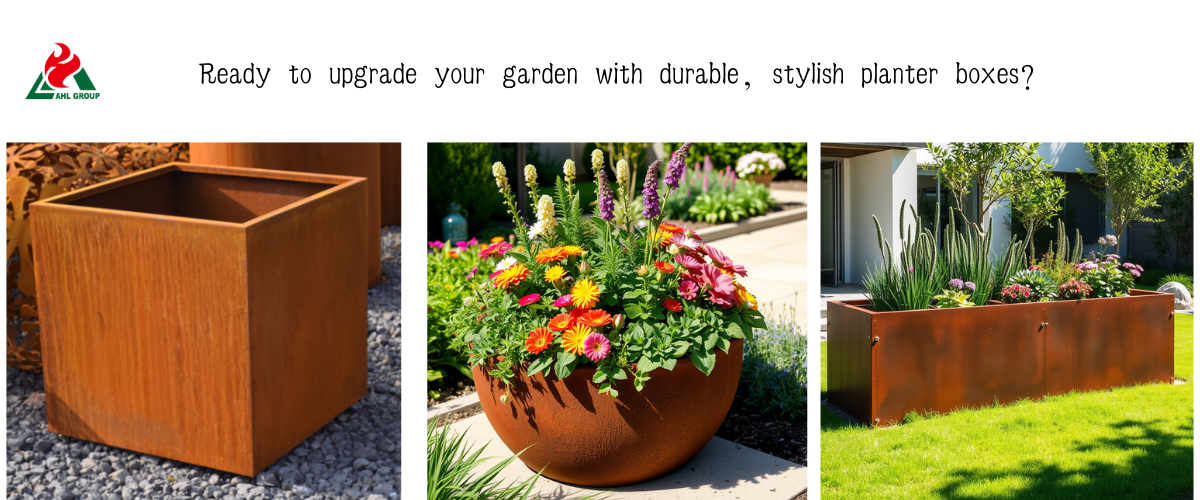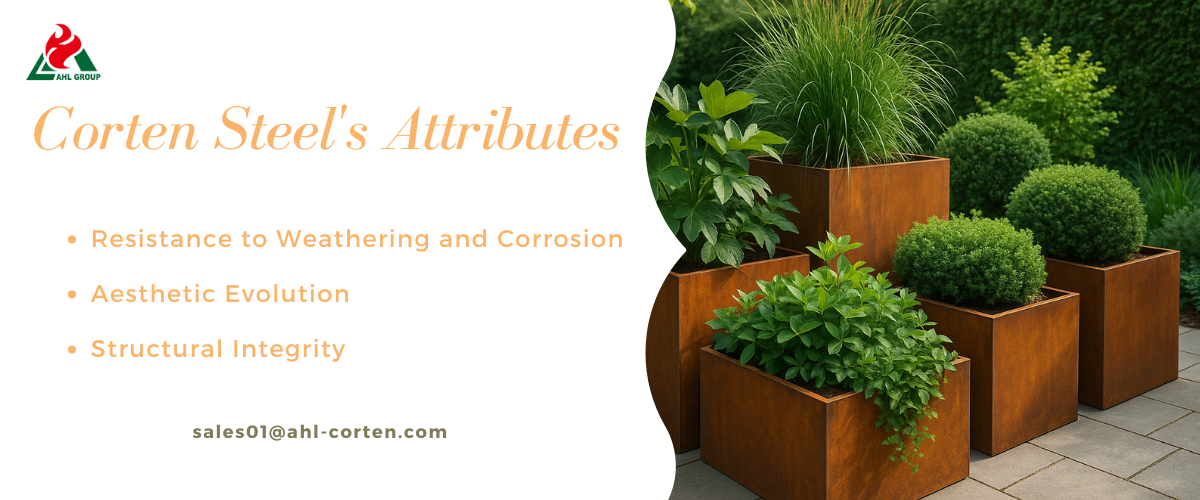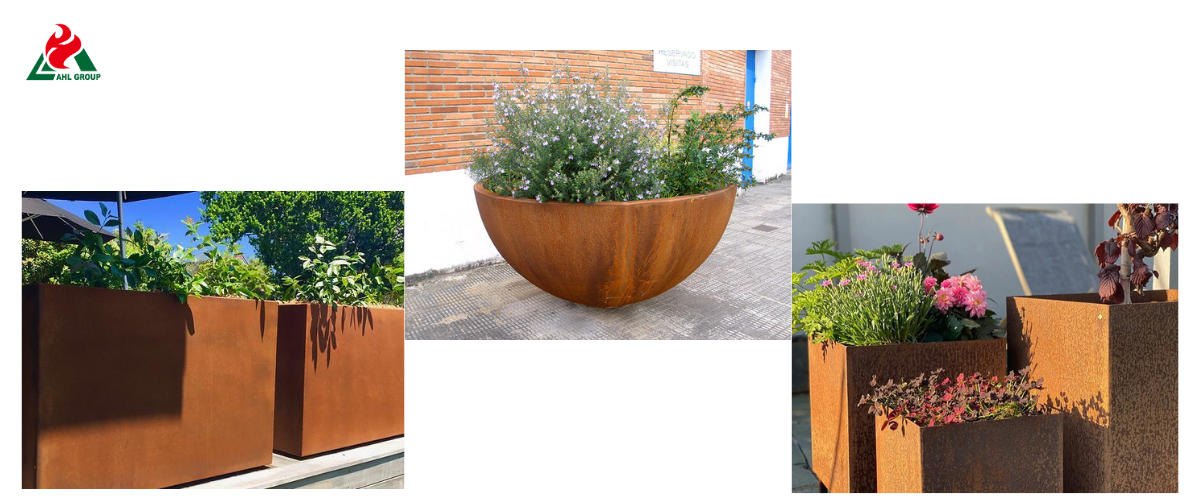As a professional gardener who works with high-end hardscaping, picking materials for planter boxes isn't just about how they look; they also have to be able to stand up to the elements, be in line with green building principles, and look good in their natural setting. One material that has consistently fulfilled these standards is Corten steel. Corten steel is known for its resistance to weather and architectural attraction, and is being used increasingly in residential and commercial landscape projects. However, is it truly the desired material for planter boxes?
This comprehensive guideline evaluates the capabilities, practicality, and relative environmental benefits of Corten steel planter boxes to assist landscape architects, contractors, and enthusiastic gardeners in making an intelligent determination

When exposed to air, corten steel—also referred to as weathering steel—develops a stable protective covering of patina. When exposed to the outside, this rust layer essentially allows the steel to mend itself by preventing deeper corrosion. Corten steel can survive in outdoor environments, unlike traditional carbon steel, which deteriorates with time.
Rusted surfaces serve as protection as well as a distinct visual effect. As the patina matures, there is a transition of the steel from bright orange to a deep, earthy brown, consistent with modern and rustic design trends alike.
Corten steel has excellent structural stability with a yield strength of 345 MPa or greater (depending on the steel grade).Because it doesn't warp, bend, or break easily, even when put under a lot of pressure from wet soil and growing roots, it's a good material for making pots that will last.

Corten steel provides durability and functionality in addition to making it the ideal option as an outdoor plant container. Its resistance against moisture and variations in temperature makes sure that planters will remain constructed and solid in any season. Furthermore, an industrial minimalist exterior allows for a perfect integration with modern landscaping designs.
Conclusion: Combining longevity, lower maintenance, and visual impact, Corten steel makes for one of the most well-balanced choices for planter boxes.
• Cleanup and seasonal care
• Periodically flush with clean water to remove soil or debris
• Refrain from using chemical cleaners; they may destroy the patina
• Keep the bottom from contacting standing water to avoid staining the pavement
• Runoff control and surface staining
Over the first 6-12 months, Corten planters may seep out rust particles that stain concrete or tile. Solutions include:
• Elevating the planter over the riser
• Installation of a sealed base
• Coating with a protection sealer after the patina has formed
• The patina will be inert and will not leach out once stabilized
Corten steel is 100% recyclable, reducing environmental waste to a minimum. Its increased service life decreases the frequency of replacing it, thereby lowering long-term consumption of the material.
Corten steel will not harm plants or the soil after the protective coating has been formed. There is no emission of hazardous chemicals, and, actually, it remains temperature stable, which protects the plant root system during cold snaps.

• Height and Width: The size of the planter box will be appropriate for the depth of the plant's root system and the spread of the plant.
• Drainage: Provide adequate drainage apertures to avoid standing water.
• Insulation: Consider the use of a liner to prevent roots from forming in cold climates.
Corten steel planter pots are especially suited to the following plants:
• Drought-tolerant plants (succulents, grasses)
• Perennial plants and shrubs
• Little trees (when the planter box is reinforced)
• Protect the new steel against direct exposure to highly acidic soils; in this case, it is advisable to use a liner
Corten steel has proved its worth as one of the more specialized and highest-performing materials available for outdoor planter boxes. Its self-protective patina, 25+ year service life, attractive flexibility, and lowest maintenance required make it preferable to wood, plastic, and even other metals.
For commercial landscaping projects, city facilities, or private gardens, Corten steel planter boxes are unmatched for value and durability. As more of these professionals are turning to eco-conscious and forward-thinking design solutions, Corten steel will always continue to be the preferred choice.
This comprehensive guideline evaluates the capabilities, practicality, and relative environmental benefits of Corten steel planter boxes to assist landscape architects, contractors, and enthusiastic gardeners in making an intelligent determination

Corten Steel's Attributes
Resistance to Weathering and Corrosion
When exposed to air, corten steel—also referred to as weathering steel—develops a stable protective covering of patina. When exposed to the outside, this rust layer essentially allows the steel to mend itself by preventing deeper corrosion. Corten steel can survive in outdoor environments, unlike traditional carbon steel, which deteriorates with time.
Aesthetic Evolution
Rusted surfaces serve as protection as well as a distinct visual effect. As the patina matures, there is a transition of the steel from bright orange to a deep, earthy brown, consistent with modern and rustic design trends alike.
Structural Integrity
Corten steel has excellent structural stability with a yield strength of 345 MPa or greater (depending on the steel grade).Because it doesn't warp, bend, or break easily, even when put under a lot of pressure from wet soil and growing roots, it's a good material for making pots that will last.

Applications in Horticulture and Landscape Architecture
Why Use Corten Steel for Planter Boxes?
Corten steel provides durability and functionality in addition to making it the ideal option as an outdoor plant container. Its resistance against moisture and variations in temperature makes sure that planters will remain constructed and solid in any season. Furthermore, an industrial minimalist exterior allows for a perfect integration with modern landscaping designs.
Material Comparison: Corten Steel vs. Alternatives
| Feature | Corten Steel | Wood | Plastic | Concrete | Galvanized Steel |
| Lifespan | 25+ Years | 5-10 Years | 2-5 Years | 10-15 Years | 7-12 Years |
| Aesthetic | Evolves Naturally | Rural | Basic | Bulky | Shiny may fade |
| Maintenance | Low | High | Medium | Medium | Medium |
| Sustainability | High | High | Low | Medium | Medium |
| Structural Strength | Excellent | Moderate | Poor | Excellent | Good |
Conclusion: Combining longevity, lower maintenance, and visual impact, Corten steel makes for one of the most well-balanced choices for planter boxes.
Maintenance Instructions for Corten Steel Planters
• Cleanup and seasonal care
• Periodically flush with clean water to remove soil or debris
• Refrain from using chemical cleaners; they may destroy the patina
• Keep the bottom from contacting standing water to avoid staining the pavement
• Runoff control and surface staining
Over the first 6-12 months, Corten planters may seep out rust particles that stain concrete or tile. Solutions include:
• Elevating the planter over the riser
• Installation of a sealed base
• Coating with a protection sealer after the patina has formed
• The patina will be inert and will not leach out once stabilized
Environmental Impact
Recyclability and Life Cycle Assessment
Corten steel is 100% recyclable, reducing environmental waste to a minimum. Its increased service life decreases the frequency of replacing it, thereby lowering long-term consumption of the material.
Compatibility with Plant Growth
Corten steel will not harm plants or the soil after the protective coating has been formed. There is no emission of hazardous chemicals, and, actually, it remains temperature stable, which protects the plant root system during cold snaps.

Choosing the Proper Planter Box
Design Considerations
• Height and Width: The size of the planter box will be appropriate for the depth of the plant's root system and the spread of the plant.
• Drainage: Provide adequate drainage apertures to avoid standing water.
• Insulation: Consider the use of a liner to prevent roots from forming in cold climates.
Planting Conditions
Corten steel planter pots are especially suited to the following plants:
• Drought-tolerant plants (succulents, grasses)
• Perennial plants and shrubs
• Little trees (when the planter box is reinforced)
• Protect the new steel against direct exposure to highly acidic soils; in this case, it is advisable to use a liner
Conclusion
Corten steel has proved its worth as one of the more specialized and highest-performing materials available for outdoor planter boxes. Its self-protective patina, 25+ year service life, attractive flexibility, and lowest maintenance required make it preferable to wood, plastic, and even other metals.
For commercial landscaping projects, city facilities, or private gardens, Corten steel planter boxes are unmatched for value and durability. As more of these professionals are turning to eco-conscious and forward-thinking design solutions, Corten steel will always continue to be the preferred choice.


